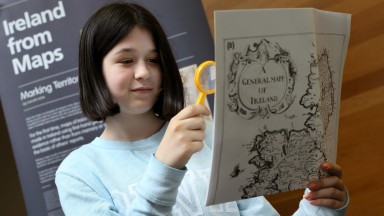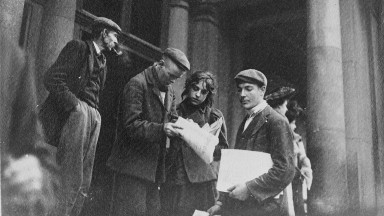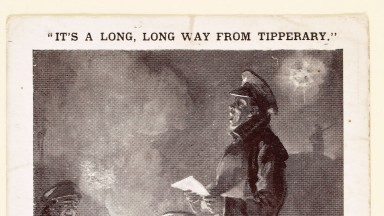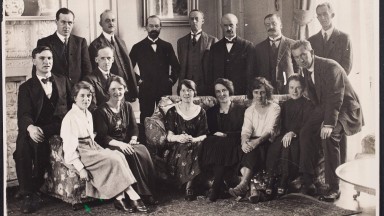Borrow a Banner Exhibition

How Borrowing a Banner Exhibition Works
Our Borrow a Banner Exhibitions are available in pull up banner format and contain information and reproductions of NLI exhibitions, and reflect its diverse collections.
The Borrow a Banner Exhibitions include between eight and twelve banners and are available for loan. The banners are easy to transport and assemble. The exhibitions can be borrowed free of charge, however host institutions must make their own arrangements for the transport and delivery of the exhibition to and from the NLI.
Listed below are the banner exhibitions we offer. Use the booking form at the end of the page or contact learning@nli.ie for further details on how to borrow the banners for your school, museum, library or other venue.
Tall Tales and Deadly Drawings
Ireland is a country of stories and storytellers. Over the years, the stories that have been written down have made their home on the shelves of the NLI. Tall Tales and Deadly Drawings recalls the books that have inspired people over generations. This exhibition celebrates storytelling, books, and reading.
In Tall Tales and Deadly Drawings, you will find some of the books you loved to read – last week or long ago – and meet books you have yet to enjoy.
The exhibition consists of ten collapsible banner stands. It is of interest to all sectors, especially to primary schools.
The Past from the Press
Newspapers are full of information that provides us with important primary evidence about the past. As with all historical evidence, there is more to a newspaper than first meets the eye.
The Past from the Press explores issues such as news values, bias, subjectivity, and propaganda and encourages you to ‘read between the lines’ of historic and contemporary newspapers.
Although the exhibition has broad appeal, it is of particular interest to students of History and English at both primary and secondary level.
The exhibition consists of eight collapsible banner stands.

Boy selling newspapers at Harcourt Street station, 1897 (CLAR111)
Ireland from Maps
The NLI has an extensive collection of maps including some of the earliest maps of Ireland. Ireland from Maps uses some of these documents to look at some of the ways Ireland has been depicted through the ages.
The earliest maps were simple representations of the landscape of ‘home’ scratched on to clay tablets. Several thousand years later, powerful satellites allow highly accurate maps to be made by anyone with access to a computer and an internet connection. The basic purposes of the map remain the same, however: to allow people to find their way from one point to another and to describe the features of a place.
Ireland from Maps introduces basic mapping concepts and terminology as well as exploring the subtext behind some of the most well-known maps of Ireland.
Although the exhibition has broad appeal, it is of particular interest to primary and second-level students.
Ireland from Maps consists of eight collapsible banner stands.
Gallant Sons
Gallant Sons uses the NLI’s rich primary source material to explore the experiences of some of the Irish soldiers who served in the First World War.
The exhibition also tells the stories of some of the families who were left behind.
Their accounts of their own experiences bring home the huge human cost of the war and tell us something about life in Ireland between 1914 and 1918. Gallant Sons consists of eight collapsible banner stands.
Heraldry: Coats of Arms Uncovered!
Heraldry had its birth on the battlefields of medieval Europe. To distinguish themselves in battle, knights had unique identifying designs painted on their armour. The resulting ‘coats of arms’ became popular, evolving from their original purpose to become coveted status symbols.
Those responsible for the design and recording of coats of arms became known as heralds. Ireland has had its own herald since 1552. Since the 1940s, the State Genealogical Office has undertaken the work of designing and recording coats of arms in Ireland. Today the Office, usually called the Office of the Chief Herald of Ireland, is based in the NLI.
Although the exhibition has broad appeal, it is of particular interest to a primary school audience. The exhibition consists of eight collapsible banner stands.
World War Ireland
World War Ireland focuses on the unique aspects of the Irish WWI experience. It draws on the NLI's collections of letters, diaries, recruiting posters, newspaper reports, cartoons, handbills, and leaflets dating from 1914-1918.
In the summer of 1914, a war broke out in Europe that would change the world forever. In Ireland, many supported the cause and joined up or travelled to serve in nursing and auxiliary services. Others objected to the war on moral, social or political grounds. By the time the conflict ended in 1918, its impact had been felt through the length and breadth of the country.
With first hand personal accounts and eyewitness testimony, World War Ireland brings visitors inside the lives of those who experienced WWI.
This exhibition comprises of ten collapsible banners.

It's a long, long way from Tipperary, postcard, 1914 (EPH A110)
If I Were A Blackbird: An exhibition on the lives of Thomas J Kieran and Delia Murphy
This exhibition celebrates the lives of the late Dr TJ Kiernan (Ireland’s first Ambassador to Australia) and his wife Delia Murphy, the renowned singer of such traditional songs as The Spinning Wheel, The Moonshiner, and Thank You Ma’am Says Dan. It uses photographs, drawings, books, and records to tell the story of the lives of the Kiernans, who during their years in Canberra sought to encourage a sense of pride in the Irish-Australian community; they emphasised the Irish role in the development of Australia and, equally, the role of Irish-Australians in the Irish quest for independence.
The exhibition comprises of eight collapsible display stands.
James Joyce’s Ulysses
To commemorate the centenary of Bloomsday, 16 June 1904, the day on which the epic adventures of James Joyce’s Ulysses take place, the NLI opened a major exhibition on the author and his most famous work.
Some of the principal themes from this exhibition have been condensed into this Borrow a Banner Exhibition which include: Joyce’s Ulysses; The Writer at Work: 1914-22; Controversy and Censorship; and Joyce’s Dublin: The City in the Book.
This exhibition comprises of eight collapsible retractable display stands.
Discover Lifelines: letters from famous people about their favourite poems
The exhibition celebrates the Lifelines project, which began in 1985 when English teacher Niall MacMonagle suggested to his Fifth Year class in Wesley College, Dublin that they do something to help those suffering in Africa. They wrote to famous people and asked them to name a favourite poem and give a reason why. The replies were duplicated on the school’s Gestetner machine, stapled together in a simple booklet and sold out in two days. Further booklets, also compiled by Wesley College pupils, were published in 1988, 1990, and 1992.
The success of the booklets resulted in the publication of the Lifelines book in 1992, with a foreword by Seamus Heaney. Lifelines 2 appeared in 1994 and Lifelines 3 in 1997. A selection from Lifelines was published by Penguin in 1993, and a further volume, a New and Collected edition, was published by Townhouse in 2006. Royalties earned on the various editions had, by 2006, raised over €100,000 for Concern to fund the organisation’s work in the developing world.
The exhibition comprises 12 collapsible display stands.
Revolutionary Lives
In 1918 and 1919, individuals from diverse backgrounds across Ireland were united by a common cause – the struggle for Irish independence. They expressed their commitment to that cause in the defiant words of speeches, articles, and letters.
This Borrow a Banner Exhibition features the ‘revolutionary lives’ of six varied individuals and reveals their involvement in the events of 1918-1919.
The six individuals featured are: Laurence Ginnell, Lily Mernin, Thomas Johnson, Kathleen O’Brennan, Michael O’Flanagan, and Máire Comerford.
This exhibition comprises eight collapsible display stands.

Photograph of Members of the Irish Republican Delegation in London 1921 (MS 49,835/15/8)
Living with Pride: Photographs by Christopher Robson
Living with Pride documented LGBT+ life and activism in Ireland during the nineties and noughties, and celebrated the life of Christopher Robson (1941-2013). Christopher not only captured much of Ireland’s remarkable journey toward LGBTI+ equality, in his photographs, but contributed so much to that journey through his own activism.
This fully bi-lingual exhibition can be downloaded free of charge to print and display in your venue!